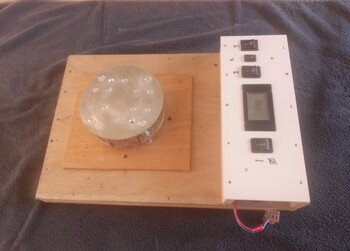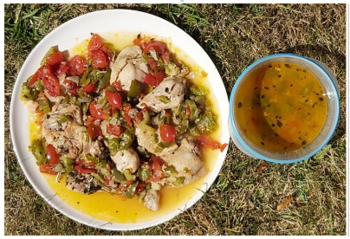PHOTOVOLTAIC SOLAR COOKING
WITHOUT BATTERIES
WITH PTC CERAMIC HEATERS
General summary of the documentation:
- Home
- Presentation of the cooker
- Design of the cooker
- 1 - Building and using a cooker
- 2 - Building a cooker: appendices
- 3 - Theoretical presentations
- 4 - Technical information
- 5 - Photovoltaic panel supports
- 6 - Automation of PTC ceramics
- 7 - Photovoltaic solar water heater
- 8 - Library
- Who are we?
the parts shown in grey are still under construction.
PRESENTATION OF A COOKER
The photovoltaic solar cooker presented here runs on the sun, without the need to store
electricity on batteries. It is designed primarily for family cooking in sunny areas where
energy resources are scarce.

The model presented here works with a single photovoltaic panel, with a capacity of around 375 Watt-peak. The cooker is fitted with PTC ceramic resistors that regulate their own temperature to around 200°C. This means that the hot plate and the cooking vessel can be completely insulated, which explains the thermal performance of the system.
Here is a video presentation produced for the CONSOLFOOD congress in July 2023 in La Coruña, Spain.
The user switches on more or fewer heating elements depending on the amount
of sunlight at any one time, in order to optimise the solar panel's output, and checks
the appropriateness of his choice by consulting a small Wattmeter on his control
console. In the event of temporary cloud cover, the insulation allows the energy
already collected to be conserved, and the cooking process continues in the
'Norwegian pot' mode. In the event of significant variations in solar flux, the
number of PTC resistors needs to be adapted to the new sunshine conditions.
However, as the resistors are self-regulating in terms of temperature, there is
no risk of burn-out due to excess heat.
Example of rice cooking: 300g of rice, 550g of water, with a 280 W-peak panel in
September 2019 in Rouen in Normandy (France); total cooking time: 55 minutes.
The cooker is designed to be built by technicians or craftsmen as close as
possible to where it will be used. Its construction is completely accessible to
a careful non-professional. All drawings and instructions are provided in parts
1 and 2 of the documentation. In the configuration proposed here, the family cooker
is to be used to complement or replace traditional cooking methods, for cooking
in water, boiling, soups, braising, steaming and self-cooking, as well as pre-cooking
(plantin bananas, etc.), excluding cooking in oil and frying.
Given the relatively low power of the solar panel compared with other cooking
methods, the temperature of the container rises less quickly than usual, but once
the cooking temperature has been reached, the actual cooking time is the same.
benchmark performance of a litre of water at 20°C brought to the boil : 35 minutes in 920 Watt/m2 sunshine with a 280 Watt-peak panel.

If you wish, you can always add more solar panels and expand
the installation, which has no size limit.
It's the drastic reduction in the price of photovoltaic panels that now makes
possible what would have been unthinkable in the last century:
the use of photovoltaic energy for thermal applications.
Outside cooking hours, or when the sun is not shining, the solar panel can recharge mobile phones or 'USB' lamps, see part 8 'library'.


